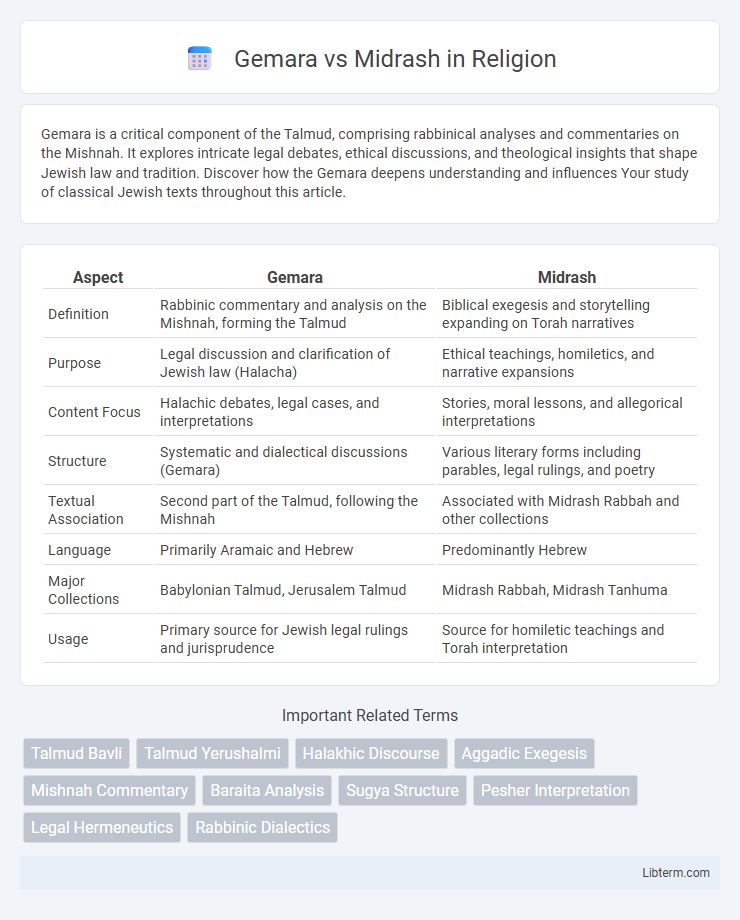Gemara is a critical component of the Talmud, comprising rabbinical analyses and commentaries on the Mishnah. It explores intricate legal debates, ethical discussions, and theological insights that shape Jewish law and tradition. Discover how the Gemara deepens understanding and influences Your study of classical Jewish texts throughout this article.
Table of Comparison
| Aspect | Gemara | Midrash |
|---|---|---|
| Definition | Rabbinic commentary and analysis on the Mishnah, forming the Talmud | Biblical exegesis and storytelling expanding on Torah narratives |
| Purpose | Legal discussion and clarification of Jewish law (Halacha) | Ethical teachings, homiletics, and narrative expansions |
| Content Focus | Halachic debates, legal cases, and interpretations | Stories, moral lessons, and allegorical interpretations |
| Structure | Systematic and dialectical discussions (Gemara) | Various literary forms including parables, legal rulings, and poetry |
| Textual Association | Second part of the Talmud, following the Mishnah | Associated with Midrash Rabbah and other collections |
| Language | Primarily Aramaic and Hebrew | Predominantly Hebrew |
| Major Collections | Babylonian Talmud, Jerusalem Talmud | Midrash Rabbah, Midrash Tanhuma |
| Usage | Primary source for Jewish legal rulings and jurisprudence | Source for homiletic teachings and Torah interpretation |
Introduction to Gemara and Midrash
Gemara is a critical component of the Talmud, consisting of rabbinical analysis and commentary on the Mishnah, focusing on legal discussions and clarifications that shape Jewish law. Midrash encompasses a broader range of interpretative writings, using stories, parables, and homiletic teachings to explore biblical texts, often revealing deeper moral and theological insights. Both Gemara and Midrash serve as essential tools in Jewish scholarship, with Gemara emphasizing legal reasoning and Midrash emphasizing narrative and ethical lessons.
Historical Origins of Gemara and Midrash
The Gemara originated around the 3rd to 5th centuries CE as a component of the Talmud, developed by Jewish scholars in Babylonia and Jerusalem to analyze and expand upon the Mishnah. Midrash, emerging earlier during the 2nd century CE, consists of rabbinic commentaries and homiletic teachings interpreting the Hebrew Bible, designed to explore deeper meanings within the scriptures. Both texts reflect evolving methods of Jewish legal and theological discourse, with the Gemara focusing on legal discussions and the Midrash emphasizing narrative and ethical interpretation.
Core Differences Between Gemara and Midrash
Gemara is a detailed rabbinical analysis and commentary on the Mishnah, forming the Talmud and focusing on legal discussions (Halakhah) and practical Jewish law. Midrash primarily offers homiletic and interpretive narratives that explore biblical texts' ethical, theological, and allegorical meanings rather than strict legal discourse. The core difference lies in Gemara's emphasis on legal exegesis and dialectical reasoning versus Midrash's focus on moral lessons and biblical storytelling.
Structure and Composition of the Gemara
The Gemara is structured as an in-depth analysis and commentary on the Mishnah, organized by tractate and featuring dialectical discussions known as sugyot. Its composition includes varied voices of Amoraim rabbis debating legal, ethical, and theological topics, often incorporating Baraitot and Scriptural citations to elucidate Mishnahic rulings. Unlike the Midrash, which mainly focuses on homiletic and narrative interpretations of the Torah, the Gemara systematically dissects legal principles through logic and dialectic argumentation within the framework of the Talmud.
Types and Approaches Within Midrash
Midrash comprises various types, including Midrash Halakhah, which interprets Jewish law, and Midrash Aggadah, focusing on narrative and ethical teachings. Approaches within Midrash often involve homiletical methods, exploring biblical verses through allegory, parables, and expansive storytelling to extract deeper meanings. This contrasts with the Gemara's analytical style, which systematically debates the Mishnah's legal rulings and clarifies Halakhic principles.
Primary Purposes: Legal vs. Interpretive
The Gemara primarily serves as a comprehensive legal analysis and commentary on the Mishnah, focusing on clarifying Jewish law (Halacha) through rigorous debate and case law discussions. In contrast, the Midrash emphasizes interpretive storytelling and ethical lessons, exploring biblical narratives to reveal deeper meanings and spiritual insights. These distinct roles highlight the Gemara's function in legal codification and the Midrash's aim to enrich biblical understanding and moral teaching.
Key Texts: Examples from Gemara and Midrash
Gemara primarily centers on detailed analysis and commentary of the Mishnah, featuring texts like the Babylonian Talmud, which examines halachic discussions and legal reasoning in depth. Midrash encompasses a broader range of scriptural interpretations, with examples such as Midrash Rabbah, offering homiletic narratives and ethical insights on the Torah and Prophets. Both texts serve distinct purposes: the Gemara elucidates legal principles, while Midrash explores narrative and theological meanings within biblical stories.
Influence on Jewish Law and Thought
The Gemara serves as the foundational component of the Talmud, offering detailed legal analysis and discussions that shape Halakhic rulings, while the Midrash provides interpretative narratives and ethical teachings that influence Jewish values and worldview. The Gemara's rigorous dialectical method refines Jewish law through case-based reasoning, whereas Midrash enriches the textual tradition by extracting moral and theological insights from the Hebrew Bible. Together, they complement each other by balancing legal precision with imaginative exegesis, deeply impacting the development of Jewish law and thought.
Methods of Study and Interpretation
Gemara employs rigorous dialectical analysis to interpret and clarify the Mishnah through detailed debates and logical reasoning, often addressing legal and practical implications. Midrash utilizes homiletical and narrative techniques to explore biblical texts, emphasizing moral lessons, allegories, and deeper meanings beyond the literal sense. The Gemara's method centers on legal exegesis and halachic development, whereas Midrash prioritizes interpretive creativity and thematic exposition.
Lasting Impact on Jewish Tradition
The Gemara serves as a foundational text in the Talmud, shaping Jewish legal principles and daily religious practice through its detailed analysis of the Mishnah. Midrash, comprising interpretative narratives and homiletic teachings, enriches Jewish tradition by providing moral lessons and deeper insights into biblical texts. Together, these works sustain an enduring legacy, influencing Jewish learning, ethics, and cultural identity across centuries.
Gemara Infographic

 libterm.com
libterm.com